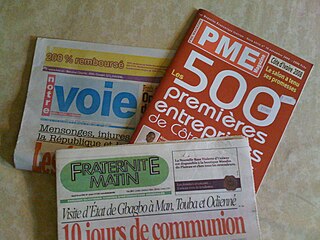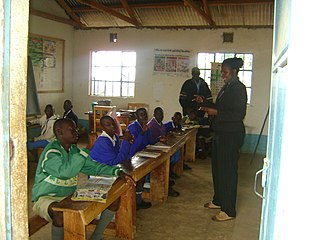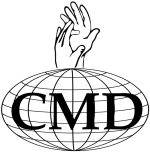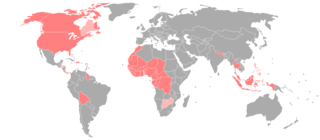Related Research Articles

American Sign Language (ASL) is a natural language that serves as the predominant sign language of Deaf communities in the United States and most of Anglophone Canada. ASL is a complete and organized visual language that is expressed by employing both manual and nonmanual features. Besides North America, dialects of ASL and ASL-based creoles are used in many countries around the world, including much of West Africa and parts of Southeast Asia. ASL is also widely learned as a second language, serving as a lingua franca. ASL is most closely related to French Sign Language (LSF). It has been proposed that ASL is a creole language of LSF, although ASL shows features atypical of creole languages, such as agglutinative morphology.

Sign languages are languages that use the visual-manual modality to convey meaning, instead of spoken words. Sign languages are expressed through manual articulation in combination with non-manual markers. Sign languages are full-fledged natural languages with their own grammar and lexicon. Sign languages are not universal and are usually not mutually intelligible, although there are similarities among different sign languages.
Signing Exact English is a system of manual communication that strives to be an exact representation of English language vocabulary and grammar. It is one of a number of such systems in use in English-speaking countries. It is related to Seeing Essential English (SEE-I), a manual sign system created in 1945, based on the morphemes of English words. SEE-II models much of its sign vocabulary from American Sign Language (ASL), but modifies the handshapes used in ASL in order to use the handshape of the first letter of the corresponding English word.
Adamorobe Sign Language or AdaSL is a village sign language used in Adamorobe, an Akan village in eastern Ghana. It is used by about 30 deaf and 1370 hearing people (2003).

Chad has two official languages, Arabic and French, and over 120 indigenous languages. A vernacular version of Arabic, Chadian Arabic, is a lingua franca and the language of commerce, spoken by 40–60% of the population. The two official languages have fewer speakers than Chadian Arabic. Standard Arabic is spoken by around 615,000 speakers. French is widely spoken in the main cities such as N'Djamena and by most men in the south of the country. Most schooling is in French. The language with the most first-language speakers is probably Ngambay, with around one million speakers.
Kwabena Joseph "Joetex" Asamoah Frimpong is a Ghanaian former professional footballer who played as a striker.

Andrew Jackson Foster (1925–1987) was an American pioneer of deaf education in several countries in Africa. In 1954, he became the first Deaf African American to earn a bachelor's degree from Gallaudet University, the American university for the Deaf, and the first to earn a master's degree from Eastern Michigan University. He earned a second master's degree from Seattle Pacific Christian College, also in education. He founded Christian Mission for the Deaf African in 1956 and set out for Accra, Ghana, where he established the first school for the deaf in West Africa.

Ivory Coast is a multilingual country with an estimated 69 languages currently spoken. The official language is French. This language is taught in schools and serves as a lingua franca in the country, along with Dioula.

The writing systems of Africa refer to the current and historical practice of writing systems on the African continent, both indigenous and those introduced. In many African societies, history generally used to be recorded orally despite most societies having developed a writing script, leading to them being termed "oral civilisations" in contrast to "literate civilisations".
Hausa Sign Language is the indigenous sign language of the Deaf community in northern Nigeria.
Linguistic discrimination is unfair treatment of people based upon their use of language and the characteristics of their speech, such as their first language, their accent, the perceived size of their vocabulary, their modality, and their syntax. For example, an Occitan speaker in France will probably be treated differently from a French speaker. Based on a difference in use of language, a person may automatically form judgments about another person's wealth, education, social status, character or other traits, which may lead to discrimination. This has led to public debate surrounding localisation theories, likewise with overall diversity prevalence in numerous nations across the West.

Deaf education is the education of students with any degree of hearing loss or deafness. This may involve, but does not always, individually-planned, systematically-monitored teaching methods, adaptive materials, accessible settings, and other interventions designed to help students achieve a higher level of self-sufficiency and success in the school and community than they would achieve with a typical classroom education. There are different language modalities used in educational setting where students get varied communication methods. A number of countries focus on training teachers to teach deaf students with a variety of approaches and have organizations to support and advocate for deaf students.

Benin is a diverse country linguistically. Of those, French is the official language, and most of the indigenous languages are considered national languages.
The French Sign Language or Francosign family is a language family of sign languages which includes French Sign Language and American Sign Language.
Bura Sign Language is a village sign language used by the Bura people around the village of Kukurpu, 40 km south-east of Biu, Nigeria, an area with a high degree of congenital deafness. What little is known about it is due to a brief visit and a videotape by Robert Blench in 2003. It is "likely ... quite independent" from other, better-known sign languages such as Nigerian Sign Language, since none of the signers have been to school and the area where it is used is rather remote.

Christian Mission for the Deaf (CMD) is a non-profit Christian organization whose goal is the bring communication, literacy, and spirituality to deaf Africans.

Black American Sign Language (BASL) or Black Sign Variation (BSV) is a dialect of American Sign Language (ASL) used most commonly by deaf African Americans in the United States. The divergence from ASL was influenced largely by the segregation of schools in the American South. Like other schools at the time, schools for the deaf were segregated based upon race, creating two language communities among deaf signers: black deaf signers at black schools and white deaf signers at white schools. As of the mid 2010s, BASL is still used by signers in the South despite public schools having been legally desegregated since 1954.

American Sign Language (ASL) developed in the United States, starting as a blend of local sign languages and French Sign Language (FSL). Local varieties have developed in many countries, but there is little research on which should be considered dialects of ASL and which have diverged to the point of being distinct languages.
Deafness in Ghana carries with it a large social stigma. Deafness in Ghana is also a variegated subject, in large part due to government policies, or a lack thereof. Deaf Ghanaians choose from a number of sign languages, with the primary one estimated to be Ghanaian Sign Language. The exact number of deaf individuals in Ghana is not known for sure, but It is estimated that there are between 110,000 and 211,000 deaf and hard of hearing people in Ghana. Deaf awareness in Ghana has been on the rise since the arrival of the educator Andrew Foster from America in 1957. There are over a dozen schools teaching deaf Ghanaians, and a number of organizations advocating on behalf of Ghana's deaf population.
In Benin, deafness affects 12,500 people out of their total population of 10 million. Since the late 1900s, there has been a growing emergence of resources, recognition, and support for the deaf people in Benin. The deaf community uses American Sign Language (ASL), Langue des Signes de l'Afrique Francophone (LSAF), and Langue des signes du Bénin. The type of sign and how many people use each remain undocumented. However, in 1994, one of the first LSAF dictionaries was published in Benin.
References
- ↑ "Home". cmdeaf.org.
- ↑ http://www.uclan.ac.uk/research/environment/projects/endangered_sign_languages_village_communities.php [ dead link ]
- ↑ https://www.ajol.info/index.php/spl/article/view/116483
- ↑ https://www.researchgate.net/publication/49821848_South_African_Deaf_Education_and_the_Deaf_Community
- ↑ "Deaf in Tunisia | Deaf Unity".